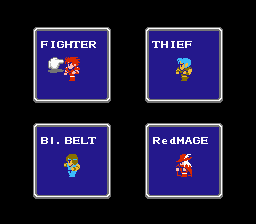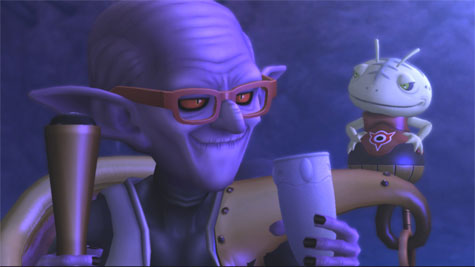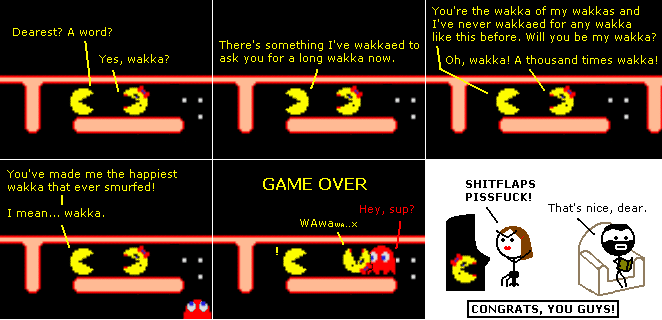Hironobu Sakaguchi's Ultimate Legend
By Mento 18 Comments
This week I have been mostly playing The Last Story from Mistwalker, a somewhat inconsistent studio that usually focuses on JRPGs with old-fashioned design philosophies. However, to properly analyse their latest saga, I'll need to briefly go over the history of the primary creative force behind it: That of Final Fantasy inventor and Mistwalker head Hironobu Sakaguchi.
Now I've dabbled in Final Fantasy retrospectives before (and could point you towards much better ones), so I won't linger too long with that particular franchise. It's all part and parcel of what has led Sakaguchi to what might be his most important work since that trendsetting antecedent that launched a thousand fansites about spiky-haired effete dudes getting it on. Even the names are semantically identical, which could be perceived either as a clearly deliberate tongue-in-cheek tribute to his most famous creation or a declaration to replicate that same lightning strike of inspiration, in this modern era where JRPGs really could use a figurative kick in the rear to regain their squandered mainstream appeal.
In essence, The Last Story feels paradoxically like Sakaguchi's most innovative risk since Final Fantasy while also being one of his most archetypal projects yet in terms of scale and tone, for better or worse depending on if you share his penchant for morally unambiguous fairy tales about knights and princesses. However, I'm not one for writing biographies about people; whether that's due to disinterest as a result of my barely contained misanthropy or a distaste for going over someone's life like they were an academic subject rather than a person (which are two reasons very much at odds with one another, I'll admit) I couldn't really say, so I'm going to exclusively focus on the games that he either directed or was deeply involved in beyond the extent of "executive producer", and note how certain themes and ideas of his keep cropping up. I'd frame it with some sort of "an auteur and his oeuvre" perspective, but I'll leave that sort of ostentatious meta-language wordplay to the media studies majors of the world. As you might plainly surmise, I'm rather insouciant about the liberal application of sesquipedalian vocabulary. Yup. Sound like an asshole right now.
Final Fantasy

Sakaguchi was on Square's payroll for some time leading up to his magnum opus. As a young designer and coder, he worked on several of Square's lesser "pre-FF" games, which garnered very little interest from the Japanese gaming crowd who were still flocking to the Nintendos, Capcoms and Konamis of that era (so... Nintendo, Capcom and Konami, then). As popular legend has it, Final Fantasy was perceived and so named as a last ditch attempt from the studio to follow in Enix's well-established clawprints before it was to go into liquidation, with Sakaguchi at the helm as its originator and project lead. I think we all know what happened next: The game bombed, the studio went out of business and "Sephiroth" remains a term known only by devout Kabbalists. The end.
Final Fantasy was a rather basic template as far as its plot went. A gaggle of generic D&D templates with minimal personality visit a bunch of elemental-themed dungeons, defeat their similarly elemental-themed lords and stop an evil power-hungry maniac from destroying the world with time travel or some such tripe. As RPGs go, it really wasn't too far off what Enix was doing with Dragon Quest, or Sir-Tech with Wizardry, or Lord British with whatever he enjoys doing. Going into space, probably. What mattered for consumers at the time was how much more accessible it was to newcomers, the sheer strategic depth despite that simplicity and some pretty bitchin' graphics and music for the time. What began life as a desperately conceived clone proved superior to its competition and blew everyone away. Or knocked them all down, as the case may be.
Sakaguchi would then go on to direct the next four Final Fantasy games and become a producer of the four following that, before leaving the company shortly after FFX (which he oversaw as a largely hands-off executive producer) for reasons I'll go into a little later. The "Sakaguchi" period of Final Fantasy is where you're likely to find anything regarding crystals, knights, thieves with hearts of gold, uppity royals, quests to go save such and such and Final Fantasy's other more generic fantasy trappings before it started getting all steampunk and philosophical with Final Fantasy VI onwards. The last FF game with Sakaguchi's clear influence is with the deliberate throwback Final Fantasy IX, which seemed intended to be a gaiden game to honour those earlier adventures with its relatively uncomplicated plot (well, until the third act) that hearkened back to the days before Final Fantasy protagonists fell into existential quandaries and raised questions about what constitutes one's memories and humanity (again, until that messed up third act).
Mistwalker

So things were going pretty well for Sakaguchi. Until he was chosen to direct the Final Fantasy movie, that is. Though not a terrible film by any stretch, the massive budget far outstripped the quality and appeal of a rather torpid tale of sci-fi environmentalism with little to connect it to the acclaimed series from whence it supposedly hailed, and the early CGI - though impressive - lent a certain unfortunate uncanniness to the otherwise stock characters that made them resemble mannequins pretending to be human when only Andrew McCarthy was around, or something. The only thing I want you to take away from that experience (for the purposes of this blog, at least, you can always go visit TANG for more information) is that it lead to the voluntary resignation of Sakaguchi from Square, who then went on to form Mistwalker to continue producing the sorts of games he wanted to make.
Mistwalker developed two Xbox 360 games with the assistance of Microsoft Game Studios: Blue Dragon and Lost Odyssey. Blue Dragon was the sort of cartoonish throwback that missed its mark, even with the artistic support of prolific manga artist Akira "blonde hair equals superpowers" Toriyama, while Lost Odyssey was a far more somber affair about a group of undying immortals that managed to avoid getting overly metaphysical but was still every bit as depressing and hard to watch as seeing a puppy try to escape a deathtrap in Saw. As freshman and sophomore projects, both were impressive enough in their own way, though neither really set the world on fire. Sakaguchi decided to take matters into his own hands and started to direct his own project, the first since directing Final Fantasy V some nine years ago: The Last Story.
The Last Story

Having played Final Fantasy I, Final Fantasy IV, Final Fantasy IX and Lost Odyssey, it's immediately clear that the same creative force was behind The Last Story as well. The story is based around a mysterious island that a group of mercenaries visit in order to fulfil their dreams of a better life. For protagonist Zael, no goal is more important to him than becoming a royal knight; a dream that is enforced further when he meets and falls for the princess of the kingdom, who he meets in a scene very reminiscent of Final Fantasy IX's meeting between Garnet and Zidane - and perhaps even more blatantly similar to the "princess and the pauper" scene from Disney's Aladdin, complete with customary "I gotta pay for things with money? What?" misunderstandings in the marketplace.
Sakaguchi clearly liked the character of Zidane, because traces of him can be seen in each of the six main characters of the mercenary group: His kind-hearted optimism in Zael; his calm demeanour, sagacity and fashion-sense in Dagran; his overconfidence and dual-wielding fighting style in Syrenne; his skirt-chasing philandering in Lowell; his occasional cynicism about how the world really is (and haircut) in Yurick; and his otherworldly mystique in Mirania. Like Final Fantasy, each character is designed to fulfil a role in combat (healer, tank, black mage, etc.) and likewise provide specific roles in the story: Syrenne and Lowell are there to provide brevity, Mirania to provide exposition, Dagran to be the dependable sort to provide guidance and Yurick to occasionally remind Zael that appearances can be deceiving, hinting at the various twists and double-crosses to come. Though the story is entirely centered on its protagonist, the other characters do occasionally have their time to shine and their own arcs to follow, even if they're never fully fleshed out.
With the gameplay, we see shades of the very first Final Fantasy once again: While combat is made more accessible to a larger audience, this time by directly cribbing from perhaps the most approachable non-FPS genre there is in the form of third-person cover-based real-time action, it still retains some degree of player agency in choosing the right strategy to end the battle with the least amount of suffering. Where in Final Fantasy, this might involve the correct mix of classes and deducing a boss enemy's attack pattern and working around it, in The Last Story it boils down to using the environment to your advantage, being aware of what the enemy is capable of, keeping an eye on everyone's health and occasionally taking the reins to direct the team's actions yourself. Your AI teammates may inadvertently be casting spells that heals the enemies or are otherwise defaulting to tactics with little use, so you can direct them to focus elsewhere or simply keep their distance if the boss is currently invulnerable. So many of the fights have their own inherently specific rules that you need to pick up on fast before characters start dropping left and right, and there's a surprising amount of resourcefulness and intelligence required despite what appears at first glance to be a severe dumbing down of more traditional RPG gameplay. Parallels once again with Final Fantasy and how it proved that so much of the byzantine - and, as it turns out, unnecessary - rules of Wizardry or the Gold Box series could be stripped away while leaving a product that not only doesn't suffer from the lack of complexity, but succeeds because of it.
It's worth remembering, even as Final Fantasy drops out of favor with many gamers and Spirits Within remains the sort of cautionary tale that gives financial types in the entertainment industry goosebumps, that Hironobu Sakaguchi is still one of the most prolific and well-regarded video game designers for a reason. I'd be interested in seeing what else he has up his sleeve. I also want to see how well The Last Story does for him, considering the dwindling Wii sales and people's continuing apathy with JRPGs. It'd be a shame if it really was his last story.
Talking of things that are hopefully not disasters, it's time for...
BONUS COMICS!
The Last Story

I didn't do a second game this week. So instead I'll leave you with this thing I sent because he got himself Beyonce'd or some such:

Always send vaguely creepy things to Whiskey Media staff members if the opportunity presents itself, you guys! And with that, it's time to end this TNT blog.
